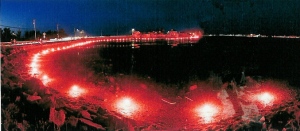Author and War of 1812 historian Gerald Altoff wrote an insightful book several years ago (still available on Amazon.com) entitled “Oliver Hazard Perry and Battle of Lake Erie”. His companion book “Amongst My Best Men”, took a more in depth look at African Americans in the War of 1812. Part of this later work focused on the African American sailors who were a part of Oliver Hazard Perry’s crew during the Battle of Lake Erie.
According to Altoff’s book many of the northern states stipulated “that each and every free able bodied white male, citizen of the respective states, resident there in, who is or shall be the age of eighteen … shall be enrolled in the militia.” While many of these states did not strictly forbid the enrollment of African Americans, they were not encouraged either. Ironically, the territory of Michigan and southern states like Virginia enlisted free men of color. In fact Louisiana had a long and proud tradition of black fighting men.
These free men enlisted in militia and rifle units that served honorably and bravely in many of the engagements of the War of 1812. It was no surprise that some of these men, probably 10-15 percent would become sailors, transferred by General Harrison and Commodore Chauncey to be crew aboard Oliver Hazard Perry’s ships.
So a few months back I got a call from internationally acclaimed and published genealogist Tony Burroughs of Chicago. Tony has quite a resume and has researched genealogy for notable African Americans like Oprah Winfrey, Al Sharpton and Olympic gold medalist Michael Johnson.
Mr. Burroughs was researching the story of freeman and war of 1812 sailor Charles Smothers. It turns out that Tony Burroughs is a seventh generation descendent of Charles Smothers who Tony believed served in the Battle of Lake Erie under Perry. This is not an easy thing to prove since men like Charles Smothers were often left out or given limited documentation in the records kept during this time period.
Mr. Burroughs shared with me his research on his great-great-great-great grandfather. “Charles Smothers was born in 1784 in Henry County, Virginia. He was a farmer and migrated from Virginia to Davidson County Tennessee, near Nashville, sometime prior to 1813 when he enlisted in the military. Smothers enlisted in the Regular Army in March of 1813. He was assigned to the 24th U.S. Infantry [and] was transferred from his army regiment to the Lake Erie fleet on August 28, 1813.”
Following these leads Tony Burroughs needed to find records that acknowledged his ancestor’s service. He found one of those on the Battle of Lake Erie website (www.battleoflakeerie-bicentennial.com) that lists all the men who participated in the Battle of Lake Erie according to the purser’s records.
Mr. Burroughs’s had corroborated this fact about Smother’s by examining the official Prize List compiled by Purser Samuel Hambleton (Commodore Perry’s Purser) which was published in The American State Papers in 1814. Tony found that Hambleton’s official Prize List indicated that Smothers “may” have served aboard the “Schooner Scorpion.”
However Tony found that Charles Smothers had stated in his application for “Bounty Land” that he served on board the “Flagship Niagara.” This contradicted the pursers report and meant that further research was needed.
It was a common practice of the era for Veterans of the War of 1812 to earn “Bounty Land” as a bonus for their service. Mr. Burroughs had found documentation that Charles Smothers made a successful application for the Bounty Land and a warrant was awarded him based on his service in the War of 1812.
Mr. Burroughs’s research also revealed that Charles Smothers continued to serve with the Regular Army but was transferred to a unit called the “First Rifles” company led by Captain Edward Wadsworth, December 13, 1813. Charles was honorably discharged on June 3, 1815 in Buffalo, New York. Instead of returning to Tennessee, he decided to settle in Fayette County, Pennsylvania. There he married a white woman named Ruth and they had several children. Two sons served in the Civil War in the Massachusetts 54th Volunteer Infantry. One of them is named Commodore Oliver Hazard Perry Smothers.
Mr. Burroughs research was painstaking and still drives him on to find that last piece of written evidence that places Smothers aboard the Flagship Niagara. But the story of Charles Smothers, African American War of 1812 Sailor is now documented. If genealogy is your passion and if you think you might have an ancestor that was aboard one of the US Navy’s ships during the Battle of Lake Erie take the time to check out the celebration website (www.battleoflakeerie-bicentennial.com). Perhaps you will be inspired to sign up to be that person during the reenactment September 2nd.







